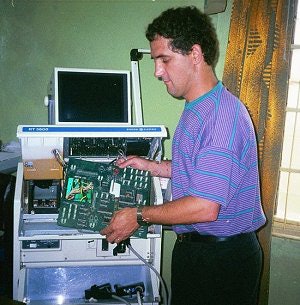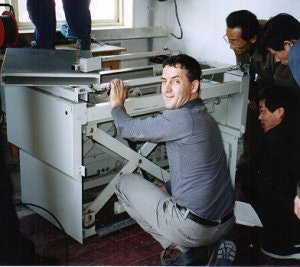
For many of us, the holidays are synonymous with shopping as we storm the malls in search of the perfect gifts for our loved ones. Attendees at the 2006 RSNA will also have the opportunity to shop as they scour Chicago's McCormick Place for that fancy-pants PACS system, a spiffy portable ultrasound scanner, or a shiny new digital x-ray unit.
But living by the axiom "out with the old, in with the new" may leave some wondering what to do with that old -- but still perfectly functioning -- imaging equipment. Why not consider donating it for redistribution to developing nations?
While the goodwill factor is immeasurable, medical equipment donation has become quite popular in the last few years, thanks to generous tax incentives in the U.S., and the improved capability of matching donors with recipients via the Internet. AuntMinnie.com offers some basic guidelines on equipment donation.
Do your homework
Donation and dumping are not the same -- if you don't want to use the equipment because it is nonfunctioning or in disrepair, then why would anyone else? Unfortunately, subpar donations do occur and generally create havoc in parts of the world that already have enough problems.
Mark Heydenburg, director of medical equipment services for International Aid (IA), recalled a much-anticipated donation of equipment, including ultrasound and x-ray units, from the U.S. to Nigeria that went horribly awry.
"The Nigerian physician spent all his personal resources and even borrowed from his family to ship the items to his hospital. He bragged to his friends and colleagues about the donation," Heydenburg said. "Upon its arrival he had a contingent of well-wishers and local news people. When the donation was opened, they were shocked to see that the items (including the imaging equipment) were in terrible condition, rusted, in disrepair and shameful to everyone involved. We owe the poor and needy better that this."
 |
| Mark Heydenburg of International Aid services a donated ultrasound unit at the Bex Memorial Hospital in Onitsha, Nigeria. The sonography machine was the only item that could be salvaged from a massive donation that turned out to be full of broken and unusable equipment. |
Donating responsibly does involve some inquiry and preparation. "Donated equipment may be useful and good, but the 'homework' has to be done by the donor in collaboration with the potential receiver. Otherwise, equipment donations often are (in the best case) useless," said Dr. Harald Ostensen, coordinator of diagnostic imaging and laboratory technology for the World Health Organization (WHO).
In other words, make sure the potential recipient actually wants it and never send a donation unannounced. WHO publishes a free, downloadable guide for potential donors: "Guidelines for Health Care Equipment Donations."
"The donor has to ensure that infrastructure, building structure, manpower, etc., are in place to take care of and operate the equipment," Ostensen added. "A sort of contract should be set up between donor and recipient with clear instructions on who is responsible for what: customs clearance, installation, maintenance, supply of spare parts, etc. Practical details such as electric power supply (AC/DC), type of wall sockets (the U.K. 'brick,' the EU standard, or similar) have to be considered and solved before any shipment is made. Are manuals and handbooks being delivered with the equipment, and are they written in a language understood by the receiver?"
Donation middlemen
Many charitable organizations that accept and distribute medical equipment have Web sites where donors easily can get information and make arrangements online.
International Aid is one such group. Headquartered in Spring Lake, MI, International Aid calls itself "the largest refurbisher of medical equipment in the nonprofit world," rehabilitating and shipping equipment primarily to developing nations in Central America, Africa, and Asia. They also recently supplied equipment to the U.S. Gulf Coast after Hurricane Katrina.
Other organizations that can help with medical equipment donations are listed below:
 |
|
| Donation nation: Where to give | |
 |
|
Click here for additional medical equipment charities. For a business-oriented guide on disaster relief, click here. |
|
 |
|
What's needed?
"Diagnostic ultrasound (units) are the most desperately needed items. Cardiac machines are also acceptable," Heydenburg said.
"Generally, we look for basic radiographic rooms or battery-powered portables -- ultrasound (systems), mammography units, and C-arms. The best mobile units are older AMX2 or AMX110 portable x-ray (units) (GE Healthcare, Chalfont St. Giles, U.K.); these are usually repairable by technicians with a basic electronics background, and parts are general enough to obtain locally," he said. "Newer CPU-controlled portables tend to have a short life in developing countries due to data storage issues, software problems, repair knowledge needed to maintain them, and parts that are proprietary. We're especially seeking 50-Hz-compatible units; many units need their mA stabilizers changed to work in 220 V/50 Hz countries."
 |
| When International Aid handled the delivery and installation of this x-ray system to a pediatric hospital in Kaesong, North Korea, in 2004, it became the first clinical x-ray unit in the entire region. Images courtesy of Mark Heydenburg. |
Stored-energy systems are also good candidates due to unreliable power sources in developing nations. With a few exceptions, International Aid accepts "C-arms newer than the mid-'80s and rad rooms that aren't the tube cranes hung from the ceiling, which are difficult to install, ship, and manage. However, we may accept pieces on these units, such as generators, chest buckys, and float-top tables," Heydenburg said.
International Aid, and many other similar organizations, will accept donations of imaging accessories as well, such as:
- Lead aprons
- Viewboxes
- Positioning sponges
- Film markers
- Apron hangers
- Dip tanks
- Lead blockers
- Darkroom accessories
- Unexposed film
- Film jackets
- Calipers
- Spotlights
Finally, nonimaging, general hospital supplies -- scrubs, boxes gloves, microscopes, stethoscopes, splints, exercise equipment, defibrillators, needles -- are also in great demand.
To prevent another Nigerian debacle, most charity groups will screen potential donors by phone before accepting any items. Donations can be rejected on the basis of age, availability of parts, supportability, and general condition, including how well it functions as well as how it looks.
"The recipient of these devices is depending on us to provide a life-changing device that will last a minimum of three years and won't disappoint them," Heydenburg said. Service problems and parts shortages are exacerbated in developing nations, and contamination issues are magnified there. Basic equipment that utilizes easily obtainable parts is adapted most successfully in minimal-infrastructure environments.
No such thing as free?
What happens if you've done due diligence and donated equipment in good faith, but there's still a snafu, such as equipment damage during shipping? In these instances, U.S.-based charitable groups will give the donor a pass on liability.
International Aid, for one, does not hold donors responsible for damages beyond their control and does offer a written waiver of liability, Heydenburg said. "We've received donations of medical devices for more than 25 years, and have always taken all liability of items we approve for donation. We'll repair the equipment and bear expenses related to the donation if the donor isn't willing to."
 |
| American Medical Resources Foundation (AMRF) volunteers carry a shipment of medical supplies across a bridge to a remote village in Ecuador. Image courtesy of AMRF. |
Be sure to ask representatives from the charity of your choice about their liability policy as internationally based groups may have different restrictions from U.S. organizations.
In the U.S., the Environmental Protection Agency (EPA) oversees medical equipment donations. According to their rules, a donor's liability for gifted medical supplies ends at the point of donation "if proper steps are taken."
"When relief organizations pick up the donated items, legal paperwork can be signed indicating the items the hospital has donated and that the relief organization is now liable for any malfunction of the supplies when they reach their final destination," according to the EPA guidelines.
Be sure to discuss the various costs associated with the donation with the charity as policies can vary widely. Some organizations will pick up the tab for transporting the equipment; others will expect the donor to do so as the cost is tax-deductible. Heydenburg said that International Aid representatives will often deinstall equipment from a donor site simply because it makes it easier for it to be reinstalled later.
Finally, there are the potential tax deductions. Generally, a donor should be able to deduct at least the fair market value of the equipment if the charitable outfit is a 501(c)(3) organization. Depending on the donation, corporate status (C or S), and the tax status of the charity, it may be possible to deduct twice the fair market value (Section 170(e)(3) of the Internal Revenue Service code). A qualified appraisal may be required for tax purposes, as well as a written acknowledgement of the donation from the charity.
While the donation process may require some effort and legwork, the results should be well worth it.
"There are many stories where donated equipment has saved lives. We sent a portable ultrasound to Peru, and the missionary told us that the first time it was used, it saved the life of a mother and infant after identifying placenta previa," Heydenburg said.
Thomas Magliocchetti is the founder and president of the American Medical Resources Foundation in Brockton, MA. "In 1995, we sent a portable x-ray (unit) from the Leahy Clinic to a village outside of Addis Ababa in Ethiopia," Magliocchetti said. "They actually made a little building around it, and this portable (x-ray unit) became their imaging department. When I went there five years later, it was still working. These folks really took great care of it. It just goes to show the ingenuity of people, when they have so little."
By Sydney Schuster
AuntMinnie.com contributing writer
November 21, 2006
Related Reading
UnitedHealthcare, Oxford Health Plans donate imaging equipment, August 31, 2006
Siemens makes multimillion-dollar donation to Clinton initiative, September 21, 2006
Rotarians help provide x-ray system in Zimbabwe, December 2, 2002
Copyright © 2006 AuntMinnie.com



















